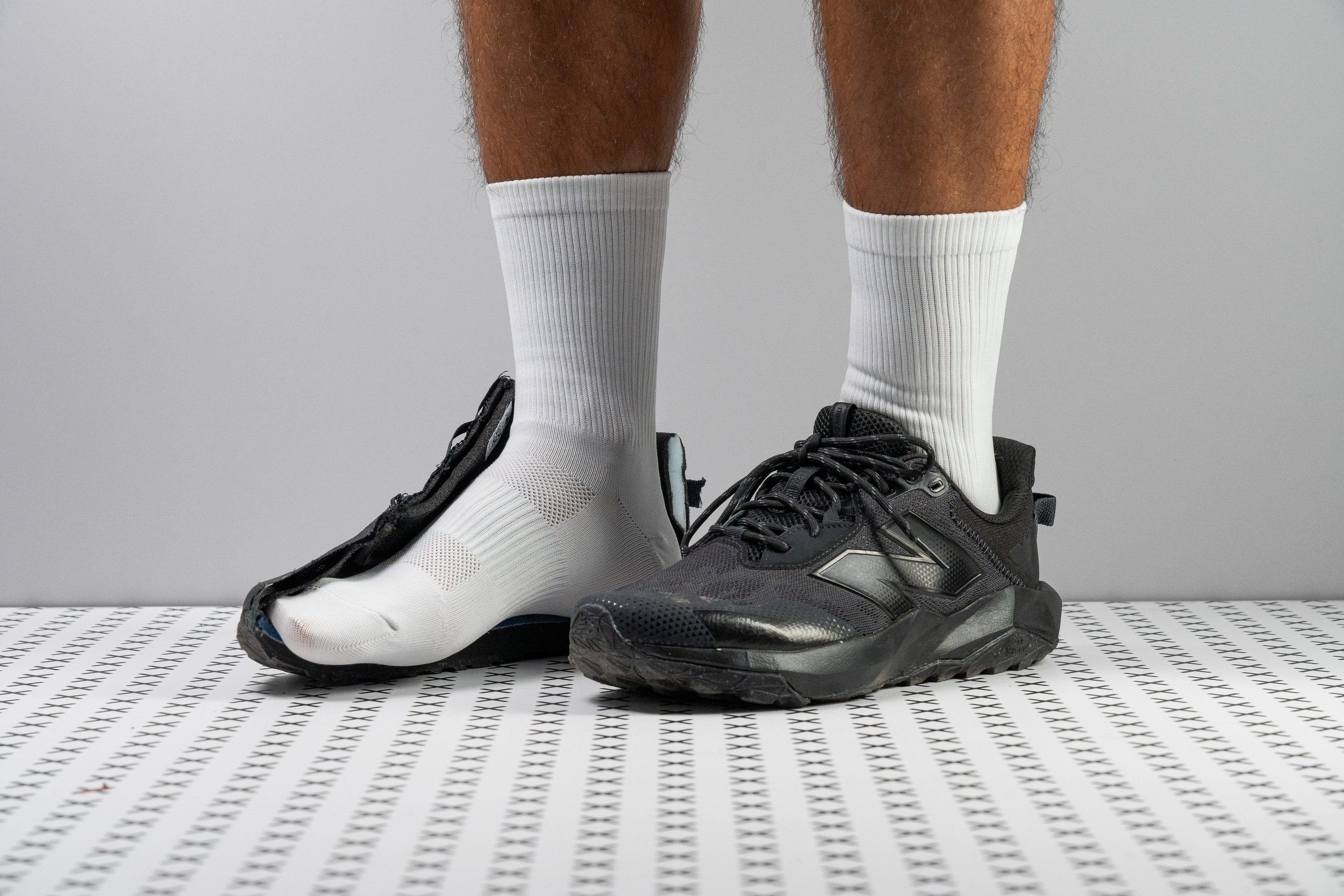Our verdict
Pros
- Comfortable for all-day wear
- Superbly stable
- Good as one-travel shoe
- Exceptional value
- Enhanced durability
- Great for hiking and walking
- Breathability
- Natural, low-to-the-ground experience
Cons
- Needs a better outsole
- Lacks cushioning
- Not for heel strikers
- Weight increase
Audience verdict
Comparison
The most similar running shoes compared
+ + Add a shoe | |||||
|---|---|---|---|---|---|
| Audience score | 75 Bad! | 76 Decent! | 74 Bad! | 86 Good! | |
| Price | £90 | £100 | £100 | £100 | |
| Trail terrain | Light | Light | Light | Light | |
| Shock absorption | Low | - | - | - | |
| Energy return | Low | - | - | - | |
| Arch support | Neutral | Neutral | Neutral | Neutral | |
| Weight lab Weight brand | 10.3 oz / 291g 10.1 oz / 285g | 10.7 oz / 302g 9.9 oz / 282g | 11 oz / 312g 11.5 oz / 326g | 9.9 oz / 282g 10.4 oz / 294.8g | |
| Drop lab Drop brand | 2.5 mm 6.0 mm | 8.0 mm 8.0 mm | 8.2 mm | 9.2 mm 8.0 mm | |
| Strike pattern | Mid/forefoot | HeelMid/forefoot | HeelMid/forefoot | HeelMid/forefoot | |
| Size | True to size | Half size small | True to size | True to size | |
| Midsole softness | Balanced | Balanced | Balanced | Balanced | |
| Difference in midsole softness in cold | Small | Normal | Small | Big | |
| Toebox durability | Decent | Good | Decent | Bad | |
| Heel padding durability | Decent | Decent | Bad | Bad | |
| Outsole durability | Good | Decent | Good | Decent | |
| Breathability | Moderate | Breathable | Moderate | Moderate | |
| Width / fit | Medium | Medium | Narrow | Medium | |
| Toebox width | Medium | Wide | Medium | Wide | |
| Stiffness | Moderate | Stiff | Stiff | Stiff | |
| Torsional rigidity | Flexible | Moderate | Moderate | Moderate | |
| Heel counter stiffness | Moderate | Moderate | Moderate | Stiff | |
| Lug depth | 2.7 mm | 2.4 mm | 2.9 mm | 2.7 mm | |
| Heel stack lab Heel stack brand | 22.7 mm 27.0 mm | 32.2 mm 32.0 mm | 33.8 mm | 32.1 mm 30.0 mm | |
| Forefoot lab Forefoot brand | 20.2 mm 21.0 mm | 24.2 mm 24.0 mm | 25.6 mm | 22.9 mm 22.0 mm | |
| Widths available | NormalWideX-Wide | NormalWide | NormalWideX-Wide | Normal | |
| Season | All seasons | SummerAll seasons | All seasons | All seasons | |
| Removable insole | ✓ | ✓ | ✓ | ✓ | |
| Orthotic friendly | ✓ | ✓ | ✓ | ✓ | |
| Ranking | #353 Bottom 4% | #341 Bottom 7% | #356 Bottom 3% | #181 Top 49% | |
| Popularity | #190 Bottom 48% | #179 Top 49% | #310 Bottom 16% | #259 Bottom 30% |
Who should buy
We've found in the lab that the budget-minded Dynasoft Nitrel v6 from New Balance it's:
- Ideal for road runners who occasionally venture onto trails and seek a robust yet affordable shoe that handles moderate off-road conditions effortlessly.
- Perfect for travellers who prioritise packing light and require a multi-purpose shoe sturdy enough for various activities—from hiking to long city tours.
- A top choice for anyone searching for a nimble, door-to-trail shoe without breaking the bank.
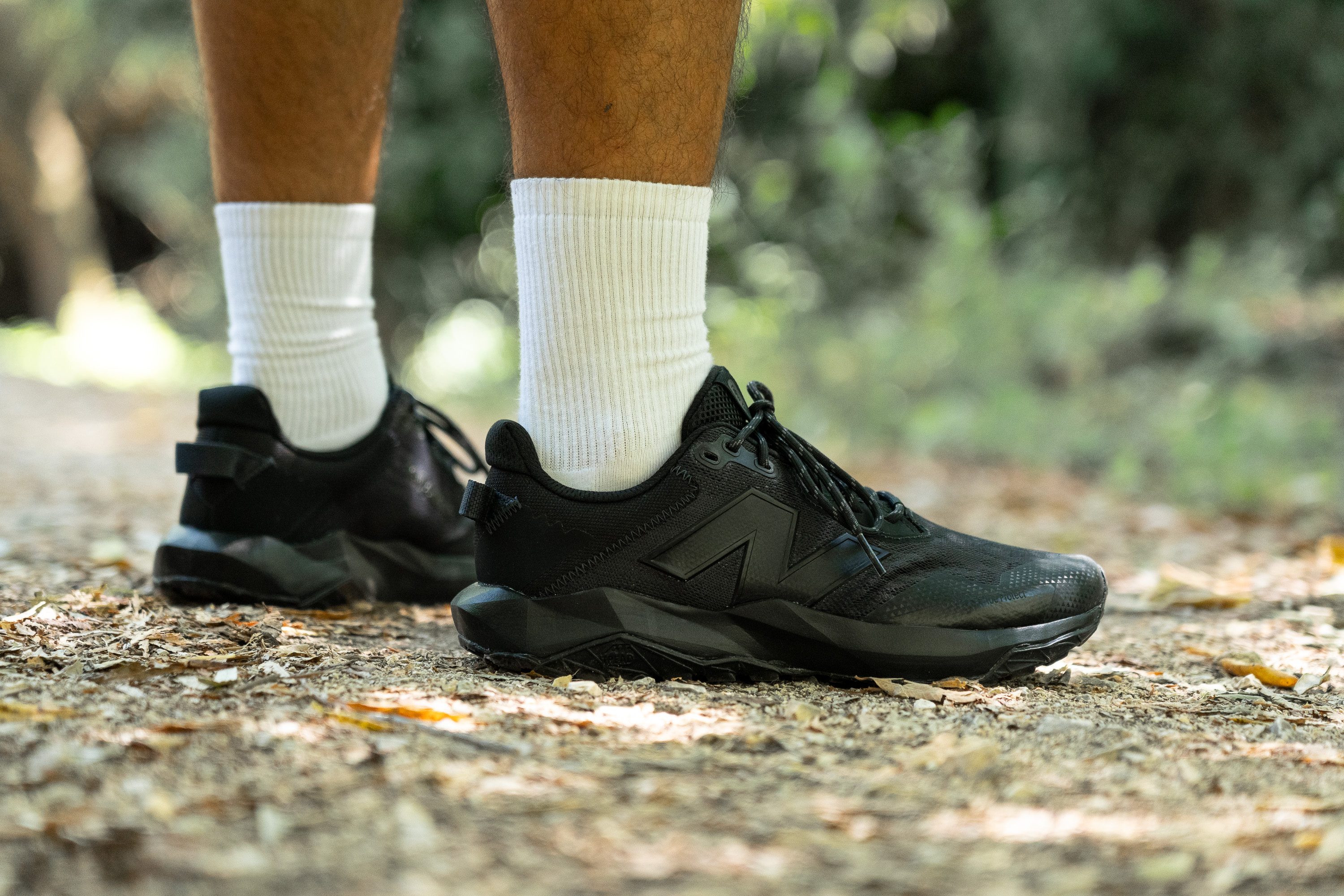
Who should NOT buy
The DynaSoft Nitrel v6 barely exceeds minimalist standards with just over 20 millimetres of cushioning in the forefoot and heel, which might not be enough for those seeking robust underfoot protection. For runners looking for a more cushioned trail experience and a higher heel-to-toe drop, we suggest exploring other trail shoes like the New Balance Tektrel or the Nike Pegasus Trail 5.
Additionally, while the Nitrel v6's outsole is adequate for light trails, we found it subpar for more challenging or technical stuff. For those who venture into tougher environments, we recommend upgrading to a trail shoe equipped with a grippy, versatile Vibram outsole—such as the New Balance Fresh Foam X Hierro v8 or the Hoka Speedgoat 6.

Cushioning
Shock absorption
With just 89 SA in the heel and 70 SA in the forefoot, the Nitrel v6 isn’t built for long adventures. It’s better suited for short runs—otherwise, cushioning simply falls short.
However, if you plan to use it mainly for hiking with the occasional jog, it works just fine.

| DynaSoft Nitrel v6 | 89 SA |
| Average | 122 SA |
Energy return
Energy return was surprisingly good considering the low price of this shoe, reaching 53.6% in the heel. That’s enough to deliver a touch of responsiveness underfoot.
| DynaSoft Nitrel v6 | 53.6% |
| Average | 55.6% |
Heel stack
If you're tired of the new trends in running shoe design featuring maximalist cushioning, the DynaSoft Nitrel v6 might be a perfect choice for you.
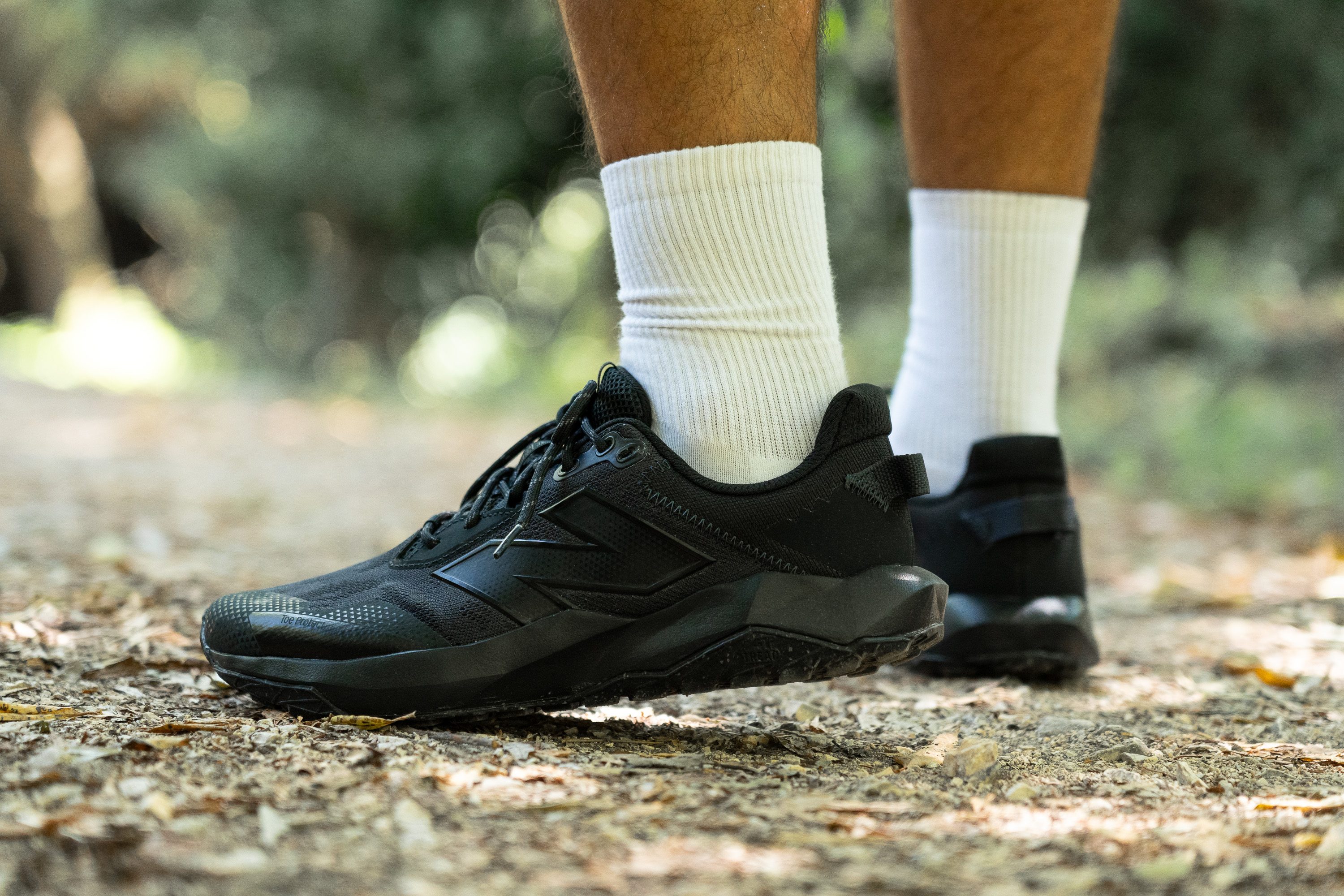
It offers just 22.7 mm of cushioning in the heel—far less than the average—providing a very grounded ride. This makes it an excellent option for runners seeking a more natural foot movement.
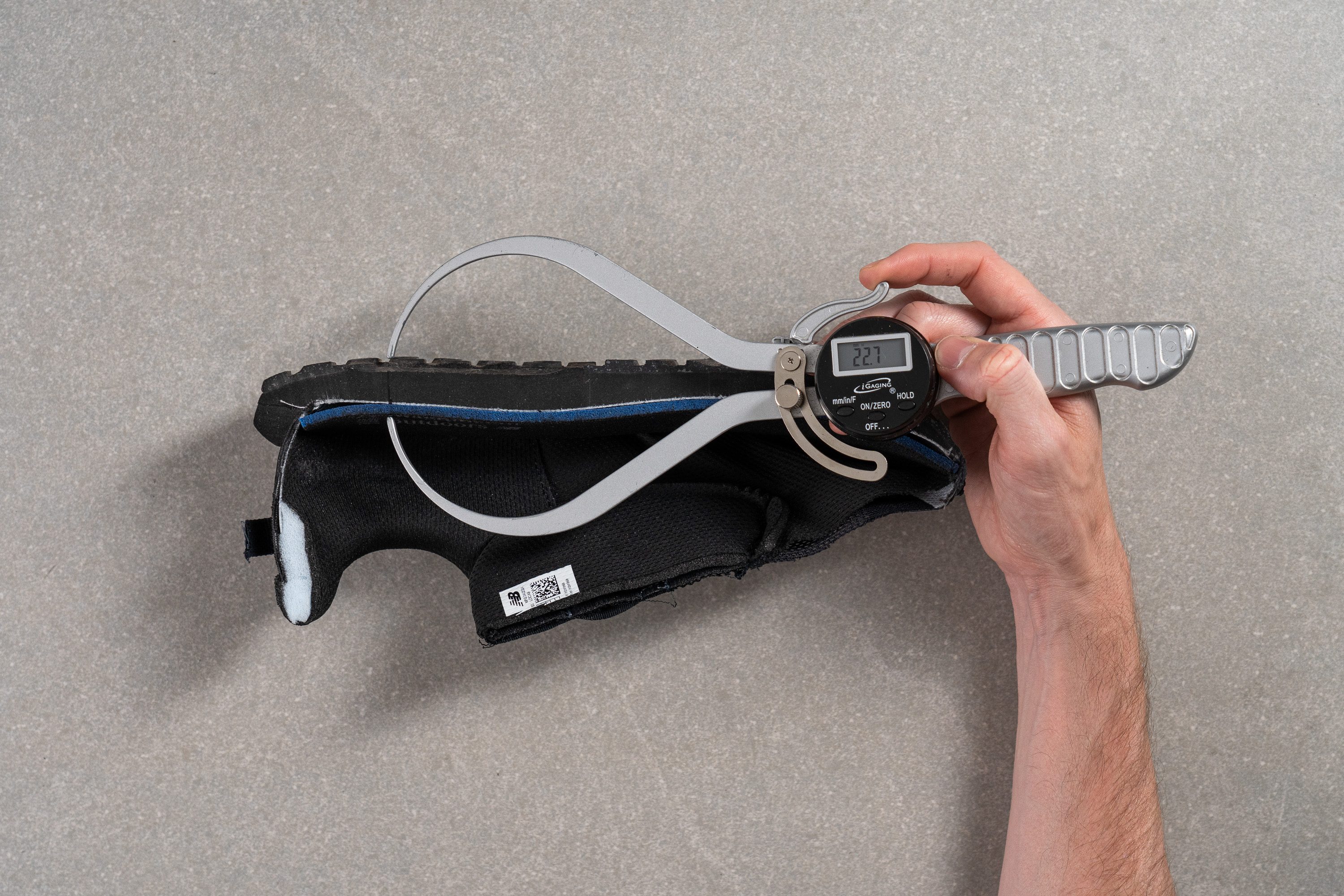
| DynaSoft Nitrel v6 | 22.7 mm |
| Average | 32.6 mm |
Forefoot stack
We used our digital callipers again and recorded a 20.2-mm stack height in the forefoot. This firmly situates it in the realm of minimalist designs, perfect for those who prefer to feel the ground beneath their feet as much as possible.
However, if you're seeking muscle protection and more cushioning, this shoe won't meet your needs. Consider opting for a budget-friendly trail shoe with a thicker midsole, such as the Nike Juniper Trail 2.
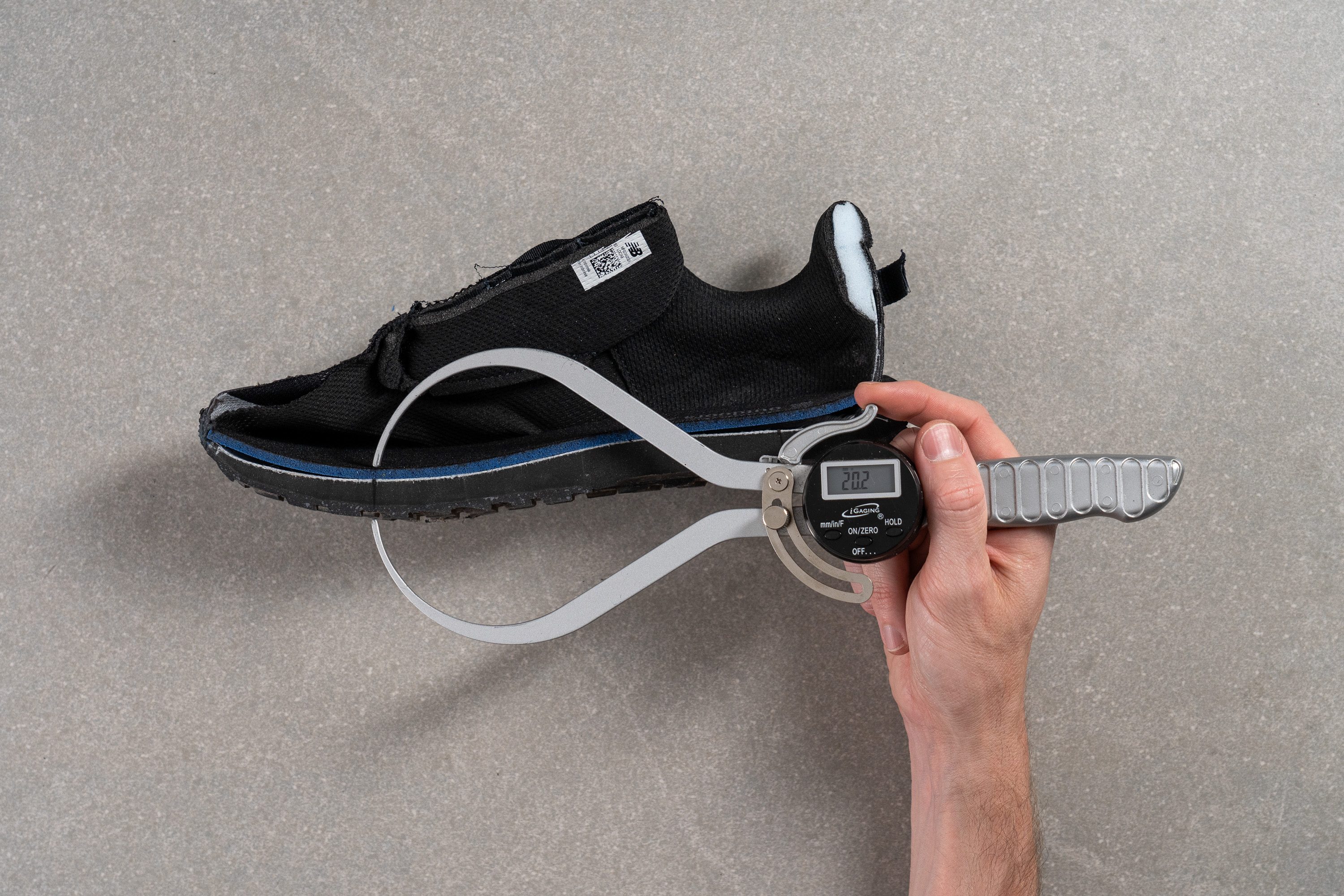
| DynaSoft Nitrel v6 | 20.2 mm |
| Average | 25.1 mm |
Drop
We discovered that the Nitrel v6 features a surprisingly low 2.5-mm offset. While unexpected, this is reasonable, considering the flat midsole design and minimal heel cushioning. Consequently, we also believe this shoe is ideally suited for midfoot and forefoot strikers.
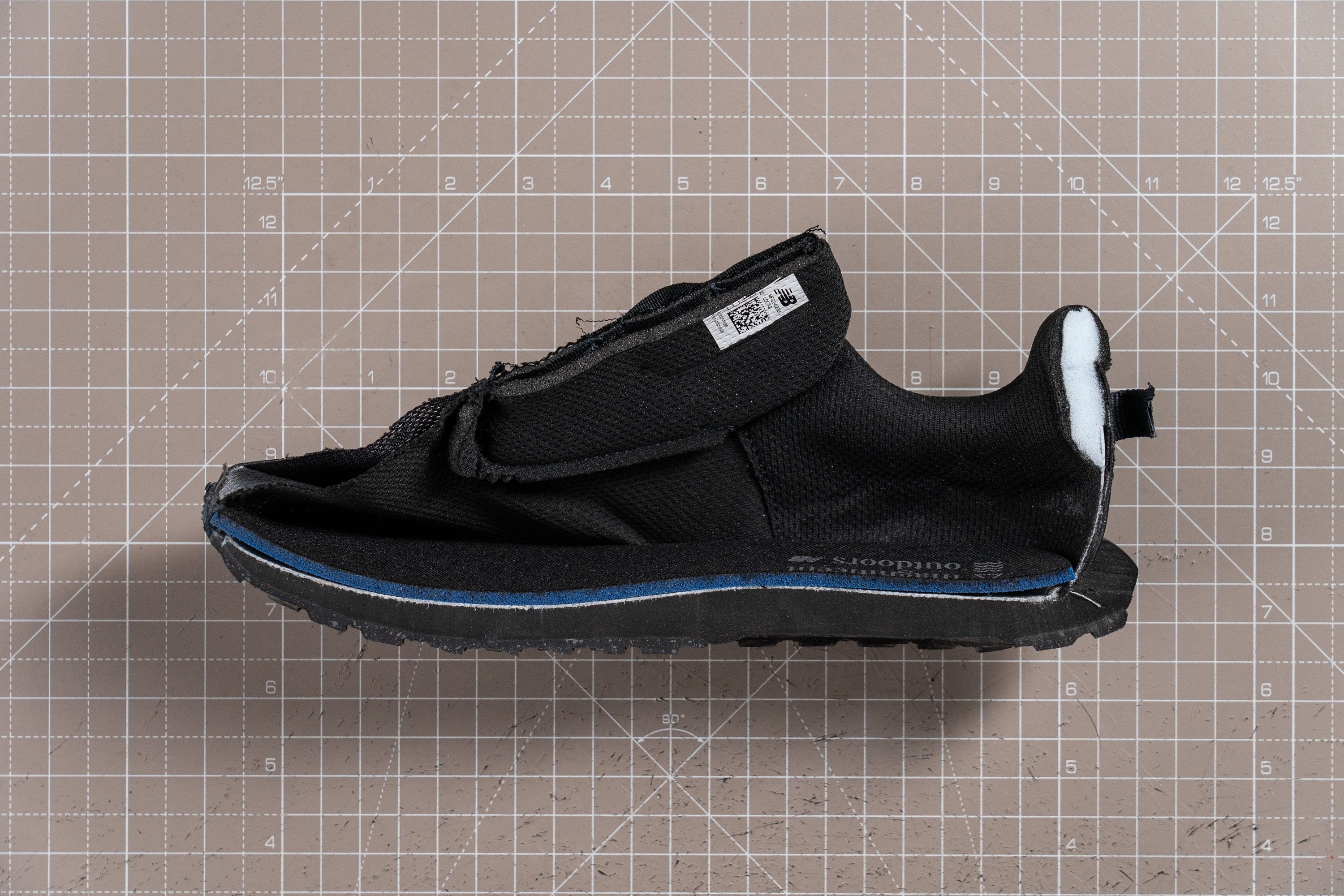
| DynaSoft Nitrel v6 | 2.5 mm |
| Average | 7.6 mm |
Midsole softness
Now let's start diving into the EVA-based DynaSoft midsole. Contrary to what some might expect, we were actually hoping for a firm midsole, as we think that a plush compound in such a thin slab of foam could mean real trouble, especially as this shoe lacks a rock plate.
The midsole proved even firmer than we anticipated, registering at 26.1 HA. This creates a ride that's definitively far from being soft—a feeling amplified by the combination of the outsole and lugs.

| DynaSoft Nitrel v6 | 26.1 HA |
| Average | 21.9 HA |
Rocker
With its low heel-to-toe drop and minimal cushioning, a highly-rockered silhouette was unlikely. Fortunately, we discovered an almost-flat sole featuring a tiny rocker that begins really late.
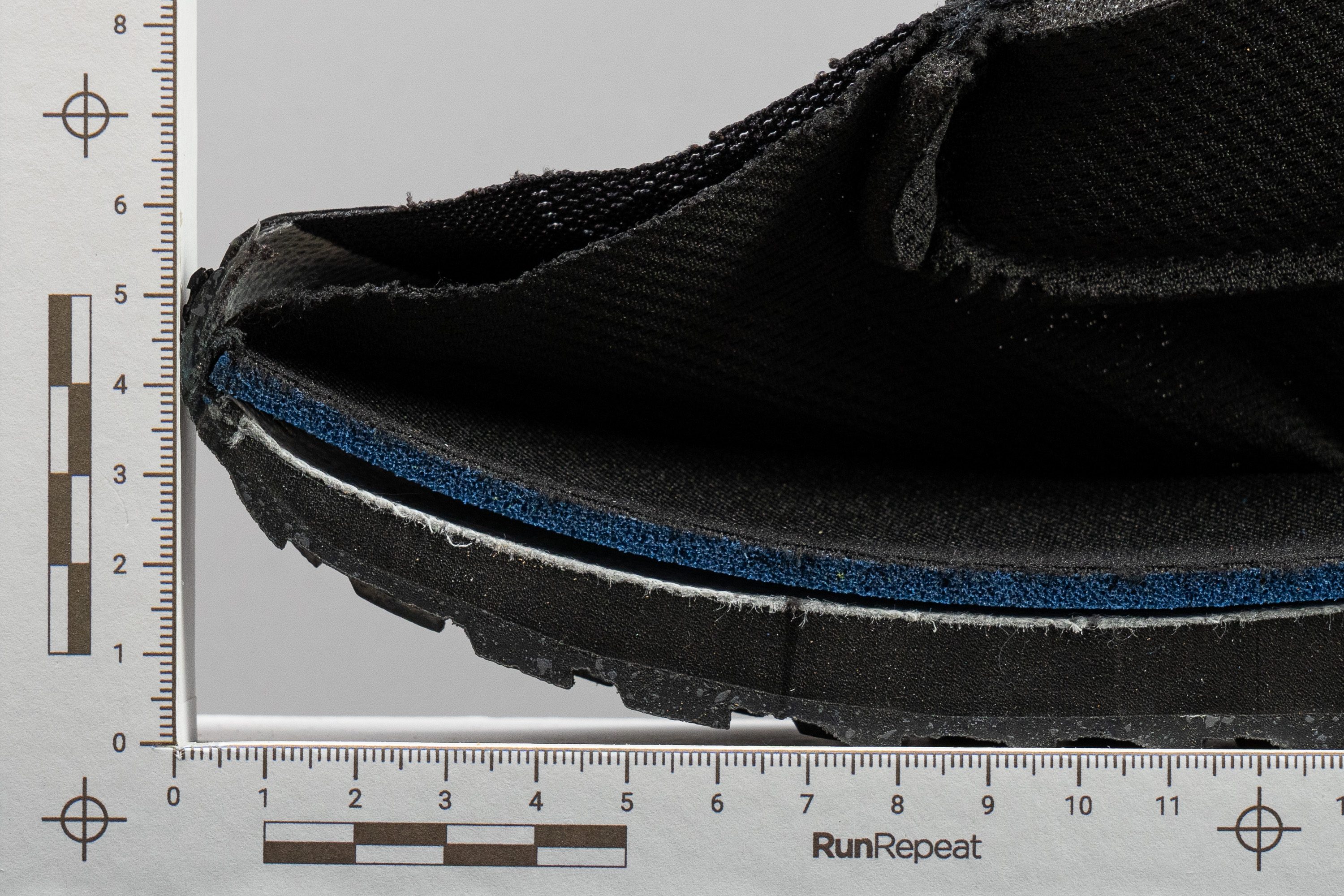
Size and fit
Size
New Balance DynaSoft Nitrel v6 fits true to size (31 votes).
Width / Fit
Like most New Balance shoes, the Nitrel v6 offers a predictable and accommodating medium-width fit, which showed up clearly in our own measurements.
Having created the shoe interiors' gel mould, we used a digital calliper to measure its widest part. At 94.5 mm, it sits right in the middle of medium-width running shoes.
Additionally, New Balance also makes this model available in wide and extra-wide options to reach an even greater target audience.
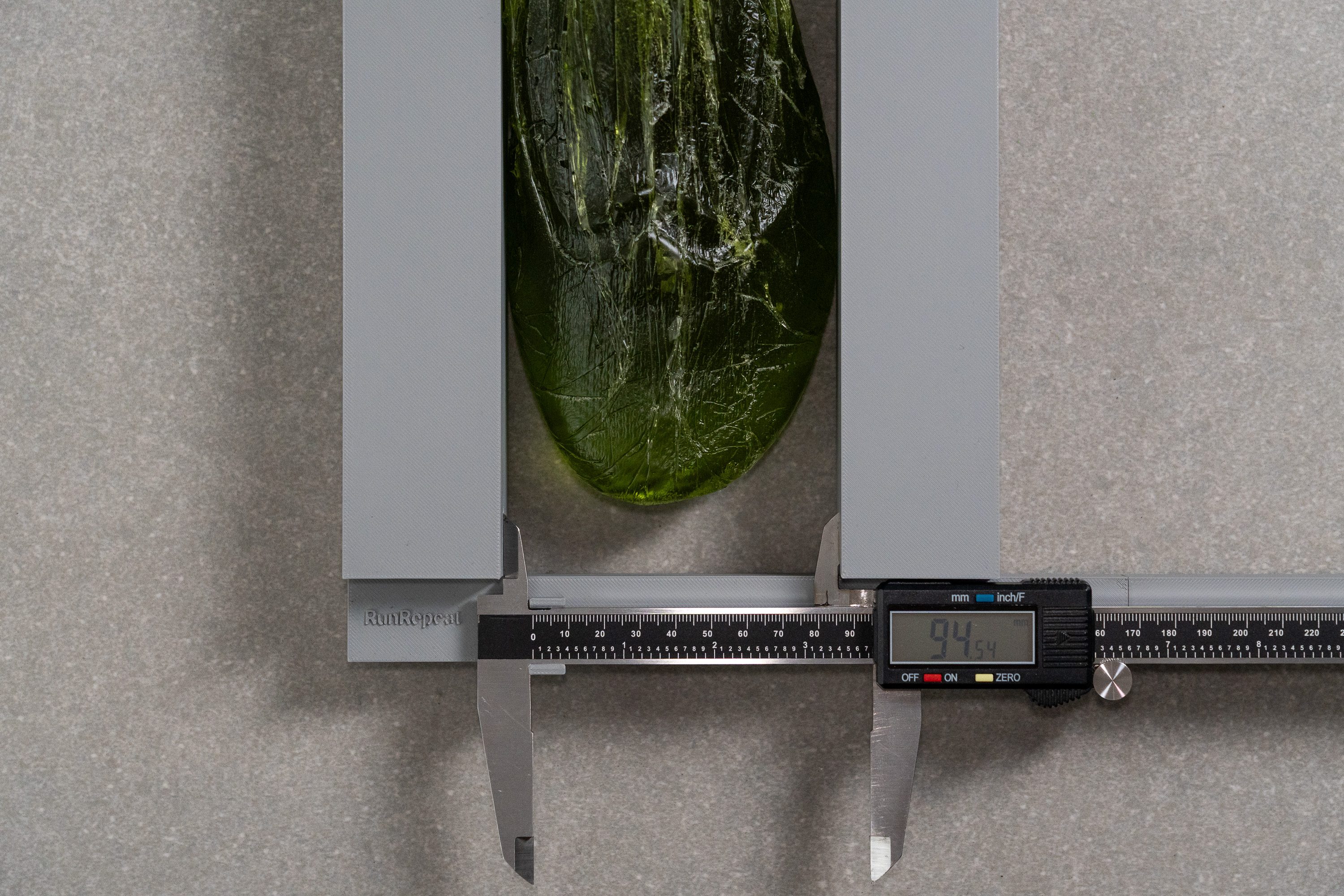
| DynaSoft Nitrel v6 | 94.5 mm |
| Average | 95.6 mm |
Toebox width
A moderately rounded toebox shape also contributes to the shoe's expected fit. There is no aggressive shoe narrowing towards the toes as our calliper showed a regular 73.2 mm width in the big toe area.
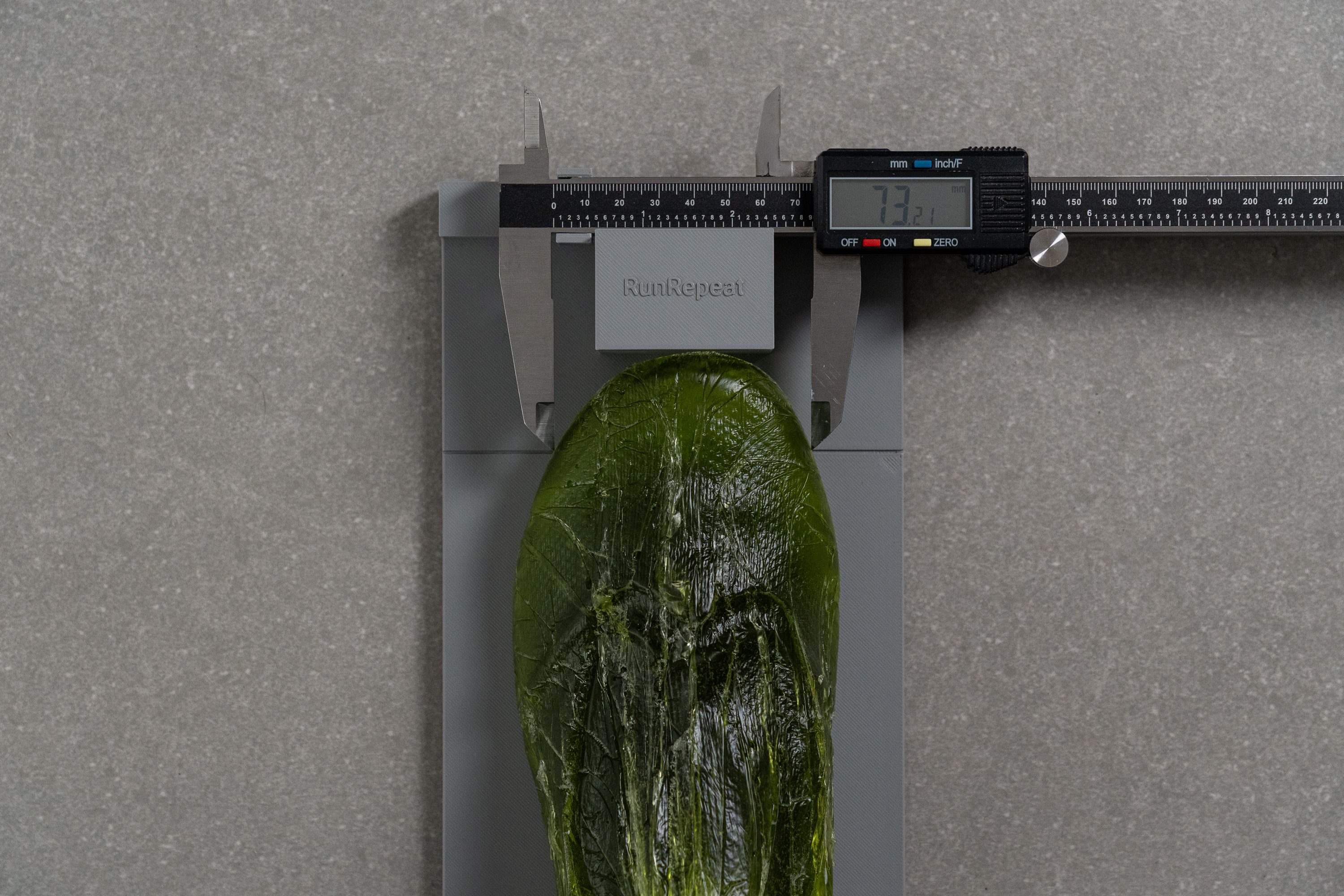
| DynaSoft Nitrel v6 | 73.2 mm |
| Average | 74.6 mm |
Toebox height
The shoe's protective overlay appears to be stealing a tiny bit of vertical space from the Nitrel but it's not critical at all. It's only within a milimeter away from the average.
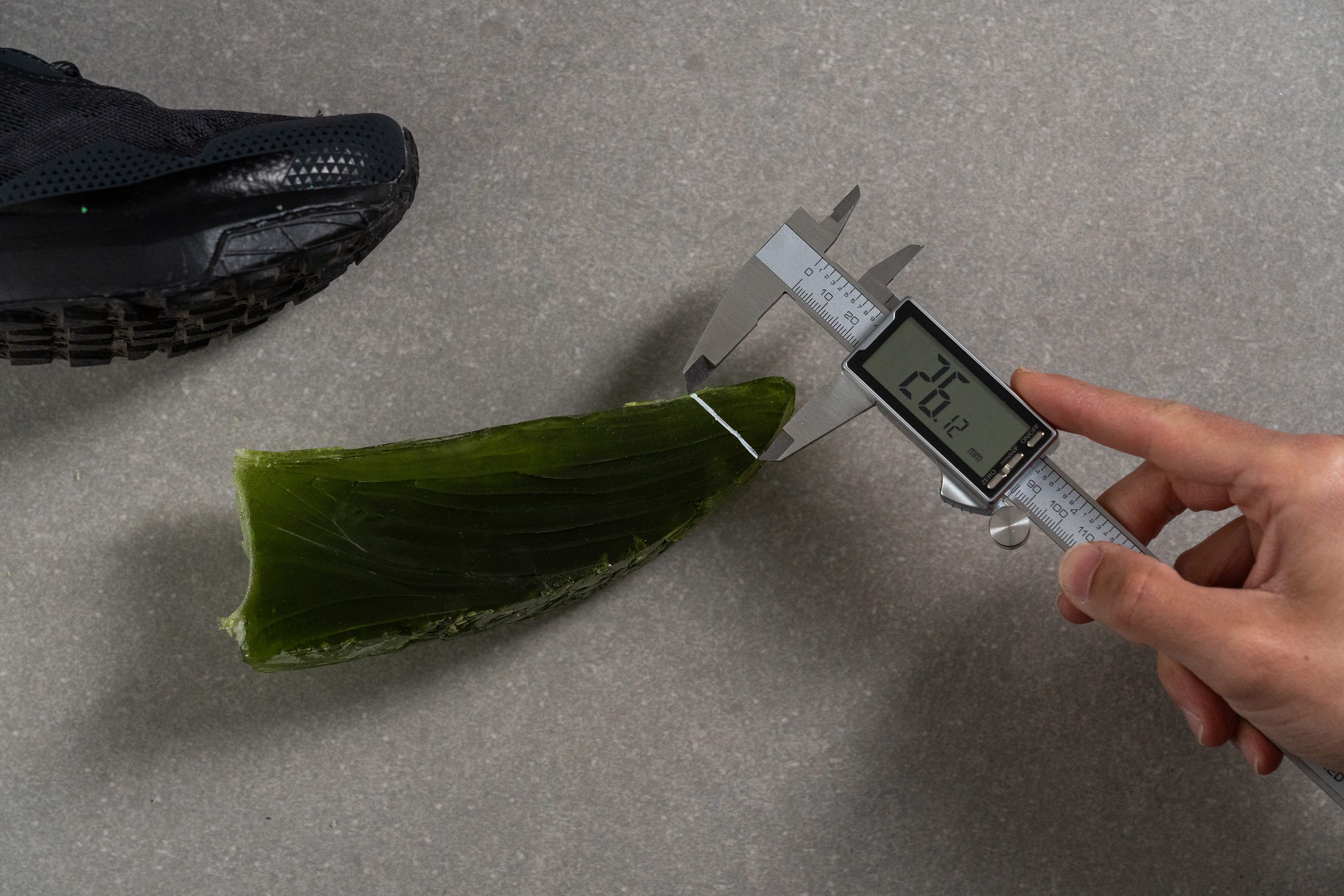
| DynaSoft Nitrel v6 | 26.1 mm |
| Average | 27.0 mm |
Traction / Grip
Forefoot traction
We tested the DynaSoft Nitrel v6 and recorded a 0.29 in our wet-surface grip test.
While dry, hard-packed trails might still feel manageable underfoot, anything slippery or moisture-heavy will highlight its grip limitations. In our view, once the rain hits, this model might be better left on the shelf and not on your feet.
| DynaSoft Nitrel v6 | |
| Average | 0.60 |
Lug depth
The lugs are fairly shallow at just 2.7 mm, making the Nitrel v6 a good option for light trails and easy hikes on flat or well-maintained surfaces like gravel roads. However, we found that this shoe isn’t the best for technical trails, as it doesn’t offer the rock-solid grip needed for more challenging terrain.
The rectangular lugs are straightforward and may struggle in truly muddy or technical conditions. Additionally, we also found that they don't work very well for sharp turns or steep inclines.

| DynaSoft Nitrel v6 | 2.7 mm |
| Average | 3.5 mm |
Outsole design
The outsole of the New Balance DynaSoft Nitrel v6 uses full-length rubber coverage with a one-piece layout and no segmentation. Its repetitive triangle-shaped lugs are laid out in a basic grid pattern across the entire surface.
There are no deep cutouts, flex grooves, or multi-zone elements. In our opinion, this simple design clearly reflects the shoe’s low price point and entry-level focus.
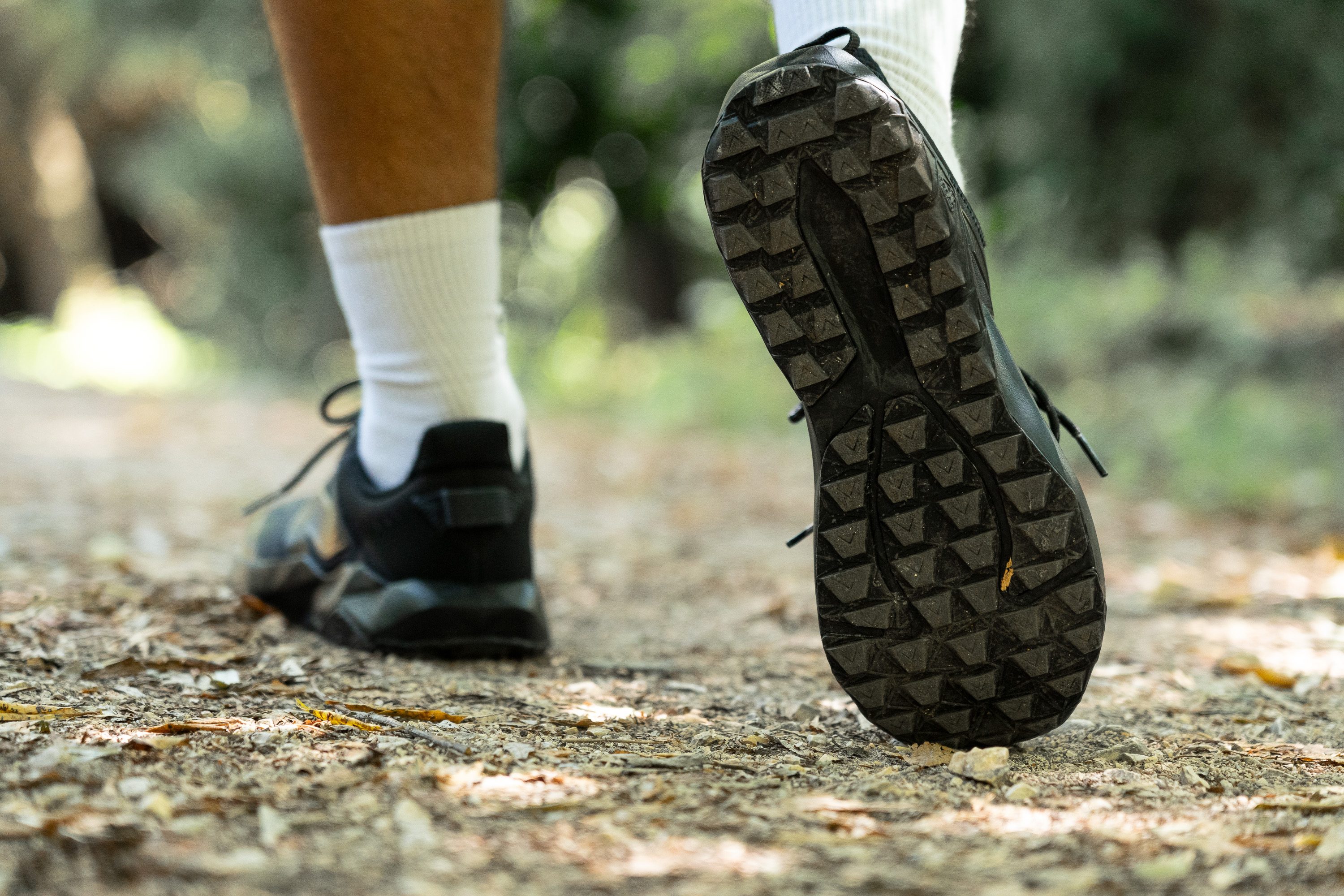
Flexibility / Stiffness
We secured the Nitrel v6 to our machine and pushed it until it hit 30 degrees of flex, just as we do with every shoe. The result? A 11.1N reading, revealing impressive flexibility longitudinal wise. This makes the shoe great for long hikes, providing comfort for those who plan to be on their feet for hours.
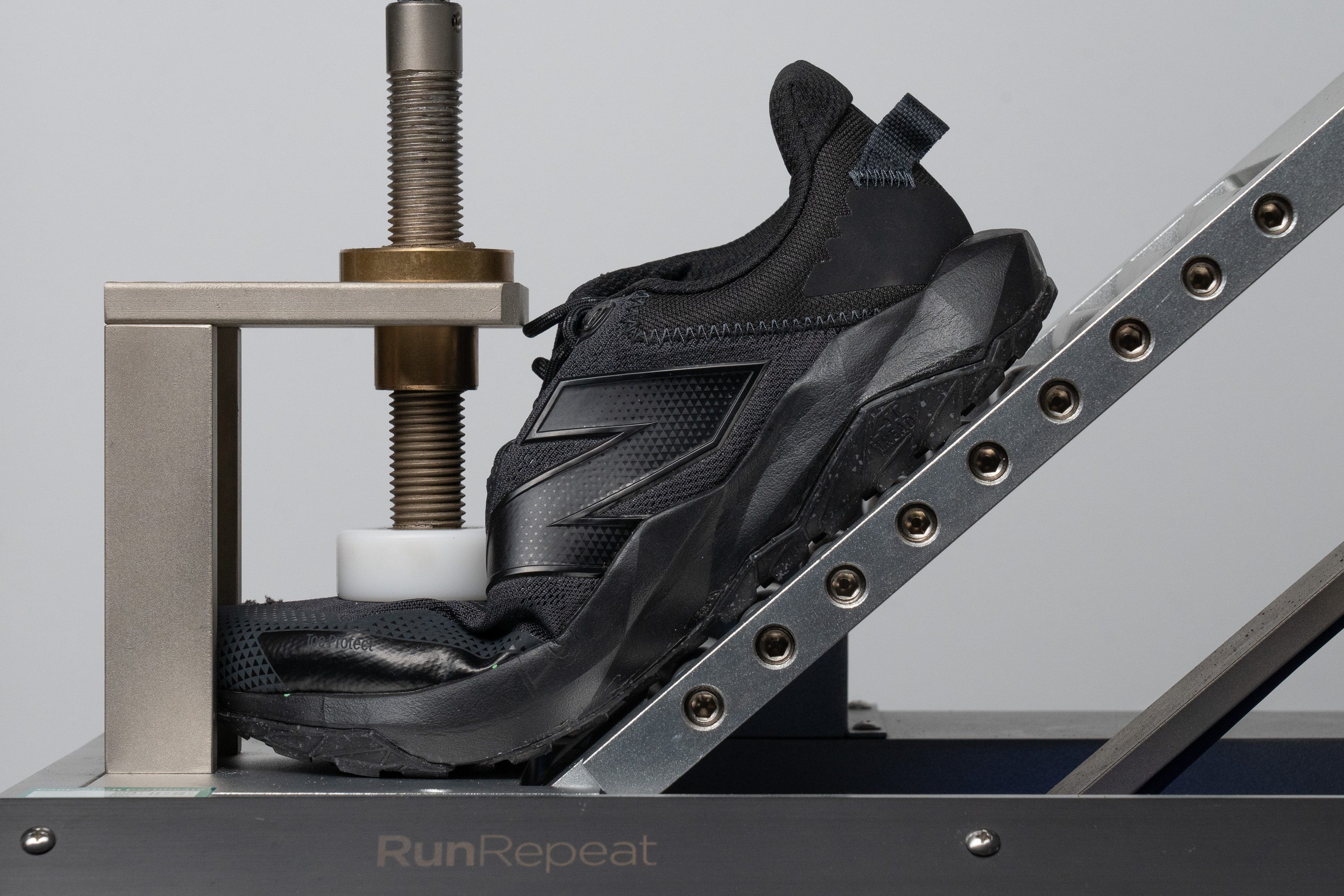
| DynaSoft Nitrel v6 | 11.1N |
| Average | 14.6N |
Weight
The triple-black colorway we bought—the only option available some weeks ago—doesn't exactly shout breathability and frankly looks about as exciting as a plate of broccoli. Still, for our lab testing, it will perform just as well as any other.
And we also found that appearances can be misleading, as the toebox proved to be surprisingly well-ventilated, earning a solid 4 out of 5 in our initial test.
We then used a light to identify where the hot air was escaping from the shoe. It turns out there's a thin, dual-layered engineered mesh upper that allows both air and light to pass through effortlessly, enhancing airflow to the forefoot.

Instead of large ventilation holes, this mesh features small, evenly spaced openings that we observed under a microscope—a smart approach for a trail shoe to enhance durability.

Upon manually examining the upper, we noted that while the quality isn't top-notch, the materials are robust and offer great value, especially considering the shoe's lower price point. And we were pleasantly surprised by the exceptional padding in the heel area!
Weight
Regrettably, the additional millimetre of rubber and the redesign have led to an undesirable outcome—it's as if the Nitrel put on holiday weight, tipping the scales past the 10-oz mark to reach 10.3 oz or 291g. For comparison, the v5 weighed 9.8 oz or 279g.
This increase in weight is disappointing, especially given the shoe’s minimal cushioning. Despite the low price point, we think that New Balance surely has room for improvement in this area.

| DynaSoft Nitrel v6 | 10.3 oz (291g) |
| Average | 10.2 oz (289g) |
Breathability
The triple-black colorway we bought—the only option available some weeks ago—doesn't exactly shout breathability and frankly looks about as exciting as a plate of broccoli. Still, for our lab testing, it will perform just as well as any other.
And we also found that appearances can be misleading, as the toebox proved to be surprisingly well-ventilated, earning a solid 4 out of 5 in our initial test.
We then used a light to identify where the hot air was escaping from the shoe. It turns out there's a thin, dual-layered engineered mesh upper that allows both air and light to pass through effortlessly, enhancing airflow to the forefoot.

Instead of large ventilation holes, this mesh features small, evenly spaced openings that we observed under a microscope—a smart approach for a trail shoe to enhance durability.

Upon manually examining the upper, we noted that while the quality isn't top-notch, the materials are robust and offer great value, especially considering the shoe's lower price point. And we were pleasantly surprised by the exceptional padding in the heel area!
| DynaSoft Nitrel v6 | 4 |
| Average | 3.2 |
Stability
Lateral stability test
The Nitrel v6 combines some of the best ingredients for a stable ride—low stack height, a firm midsole, and sturdy midsole sidewalls.
We found that these elements come together to offer a grounded, stable experience. However, it's not an ultra-stable trail shoe due to its streamlined dimensions and high flexibility.
Torsional rigidity
New Balance clearly aims for a natural, flexible ride with the Nitrel v6, which is evident from its low torsional rigidity. We found this during our bending and twisting tests. In our lab assessment, the shoe scored a 2/5 in flexibility, showing how easily it bends!
| DynaSoft Nitrel v6 | 2 |
| Average | 3.6 |
Heel counter stiffness
In another manual assessment, the heel counter scored a 3 out of 5, placing it as an average design. From our perspective, the generous padding in the back ensures your heel is securely locked in place, providing a cosy, well-cushioned fit for such an affordable shoe.
| DynaSoft Nitrel v6 | 3 |
| Average | 3 |
Midsole width - forefoot
The Nitrel v6 feels much like a road daily trainer when it comes to midsole width, especially in the forefoot. Our measurement of 111.6 mm, taken with digital callipers, confirms our initial impression of the shoe's design.

| DynaSoft Nitrel v6 | 111.6 mm |
| Average | 112.8 mm |
Midsole width - heel
The heel is narrower than anticipated, measuring only 86.4 mm compared to the v5's wider 95.6 mm. This reduction in width is disappointing, particularly because the shoe is heavier than its predecessor, and drives us to reaffirm that this design is less suitable for heel strikers.
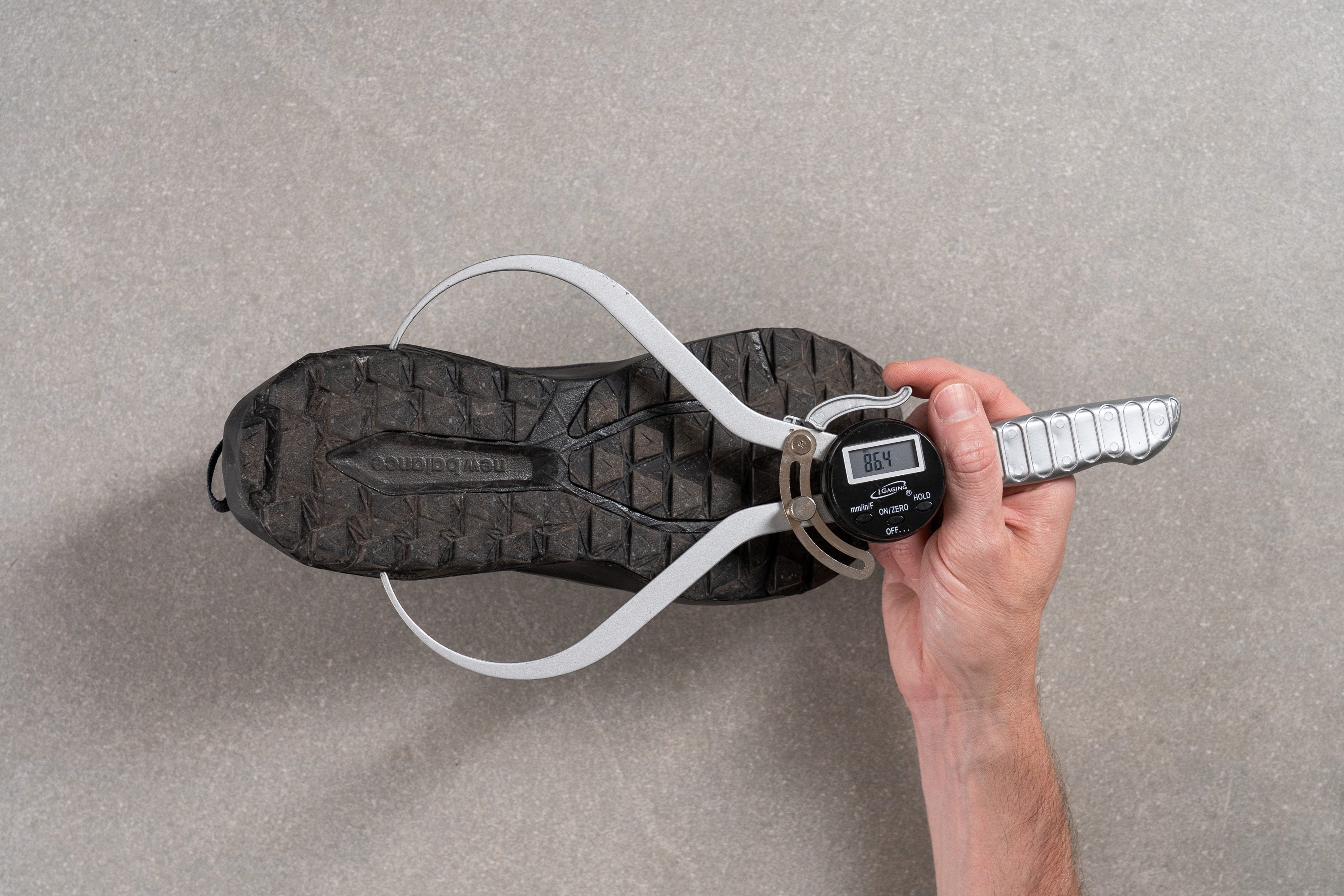
| DynaSoft Nitrel v6 | 86.4 mm |
| Average | 89.8 mm |
Durability
Toebox durability
We previously suggested that the design of the upper enhances durability because it lacks large holes, which often become the starting points for tears in technical or rugged trail terrain.
To confirm this, we tested it using our Dremel and awarded a good 3 out of 5 rating. While this isn't exceptional, it's certainly positive—especially given the extra protection in the toe cap with the Toe Protect reinforcements—yep, not the most original name—added by New Balance.
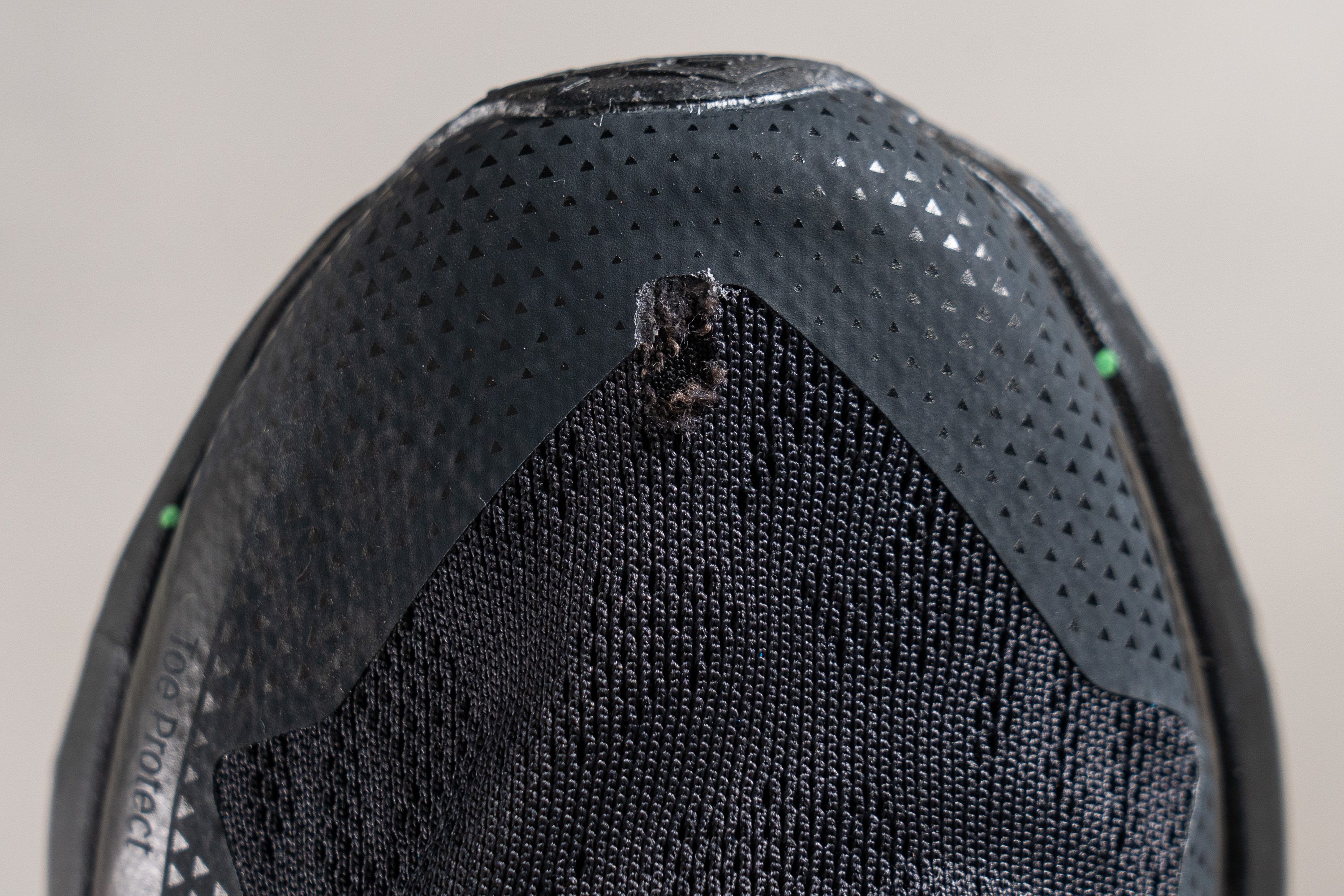
| DynaSoft Nitrel v6 | 3 |
| Average | 3.1 |
Heel padding durability
Pleased with the toebox, we proceeded to evaluate the heel padding.
Here, we again awarded a solid 3 out of 5, which is quite favourable when considering the shoe's lower price point.

| DynaSoft Nitrel v6 | 3 |
| Average | 3 |
Outsole hardness
New Balance used the same AT Tread rubber of the Nitrel v5, showing this time an average hardness that registered at 84.9 HC.
The AT Tread rubber offers reliable performance across various conditions. It provides decent grip, though not as strong as the top rubbers out there, and reasonable durability, although of course not quite on par with Continental. Yet, for the price, its value is terrific.
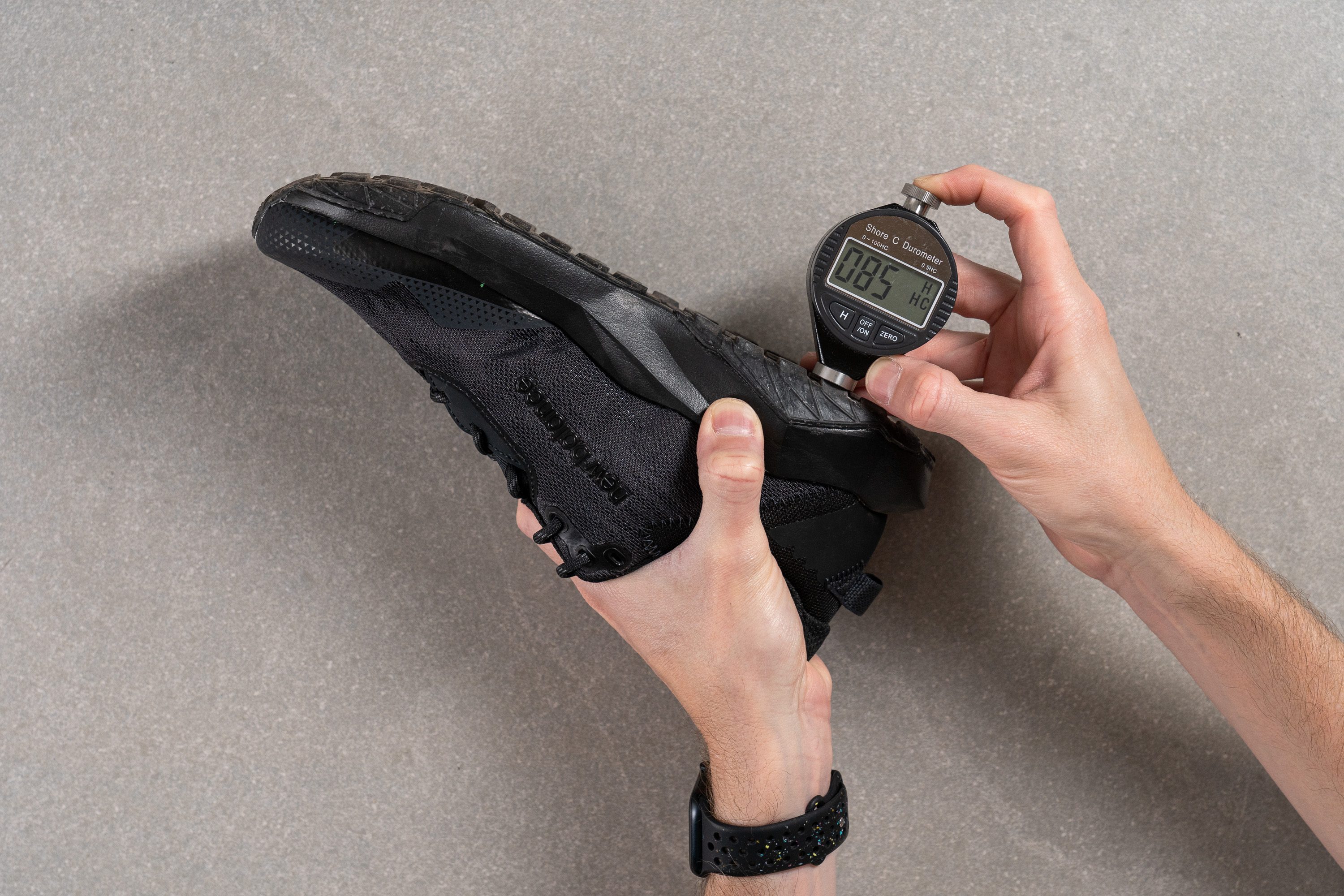
| DynaSoft Nitrel v6 | 84.9 HC |
| Average | 85.8 HC |
Outsole durability
Based on our prior experiences with AT Tread, we anticipated solid durability, yet awaited the definitive test results.
Impressively, we discovered that the rubber held up exceptionally well, sustaining only 0.9 mm of wear. This result is a solid one, ensuring the shoe's longevity even with occasional road use.
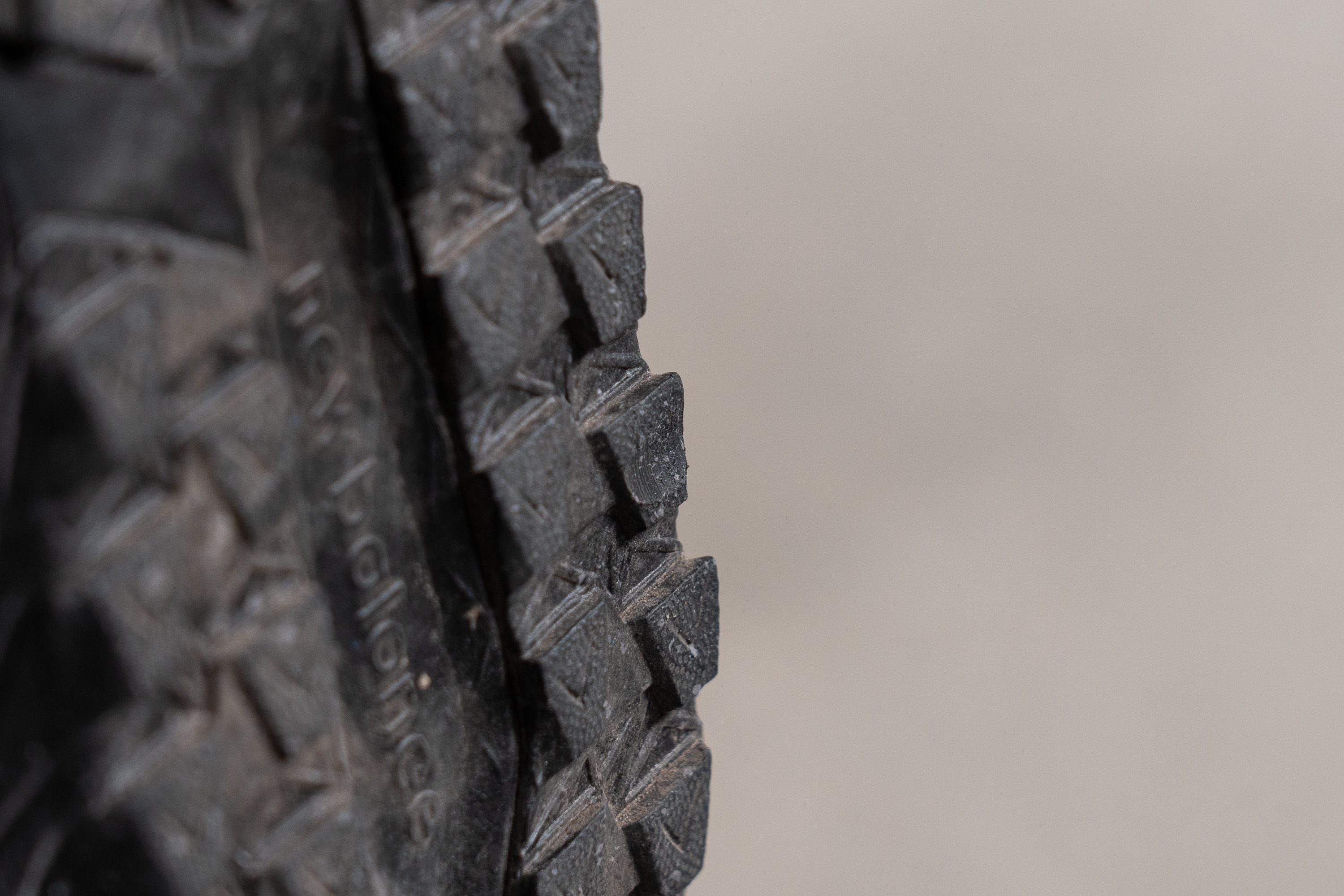
| DynaSoft Nitrel v6 | 0.9 mm |
| Average | 0.9 mm |
Outsole thickness
But if, after all, you're still worried about durability, rest easy. We discovered that New Balance has incorporated an extra-thick 3.5-mm layer of rubber beneath the midsole, enhancing its robustness.
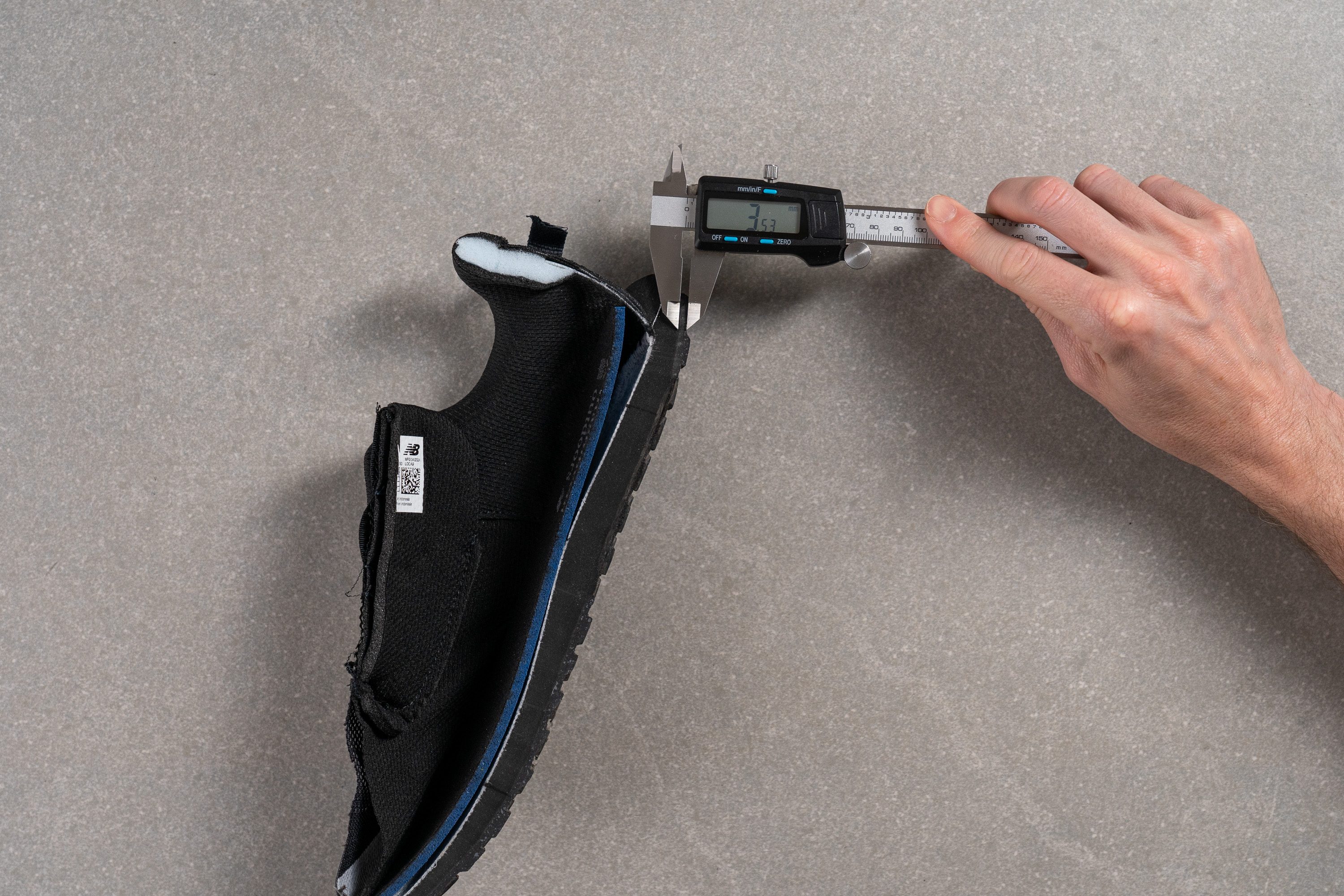
| DynaSoft Nitrel v6 | 3.5 mm |
| Average | 2.2 mm |
Misc
Insole thickness
Made from standard EVA, the insole of the Nitrel v6 is typical in every aspect, featuring a thickness of 4.2 mm.

| DynaSoft Nitrel v6 | 4.2 mm |
| Average | 4.7 mm |
Removable insole
We discovered that swapping the insole is quite easy, as removing it from the Nitrel v6 posed no difficulties. And yes, we definitely agree with New Balance's claim—the outdoors are wonderful!

| DynaSoft Nitrel v6 | Yes |
Midsole softness in cold (%)
Crafted from run-of-the-mill EVA, we were really surprised by the Nitrel v6's performance in our first cold-weather test. We discovered that it only became 18.6 % firmer!
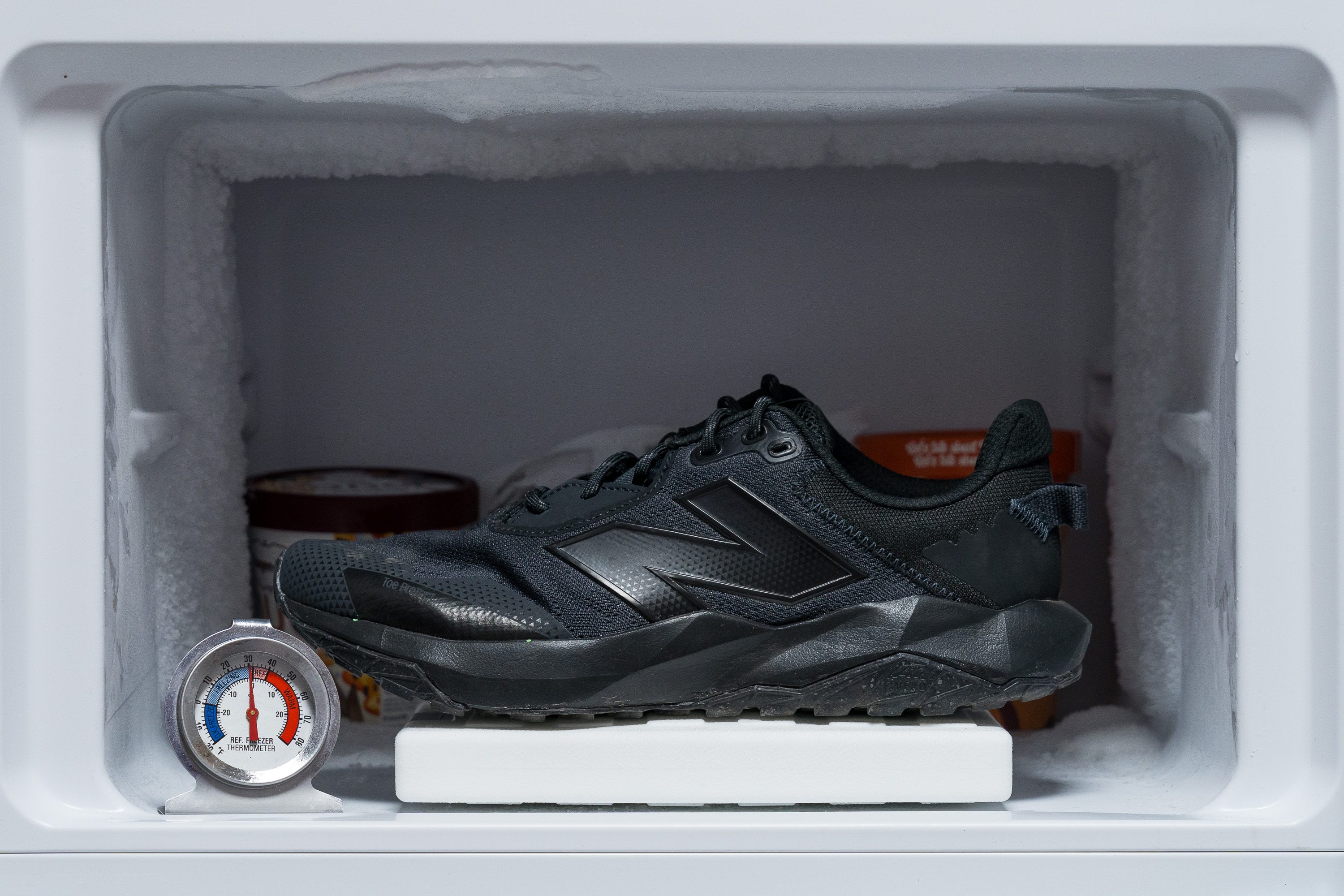
| DynaSoft Nitrel v6 | 19% |
| Average | 26% |
Reflective elements
Reflective elements are typically absent in budget-friendly trail models, a trend that continues with the DynaSoft Nitrel v6.

| DynaSoft Nitrel v6 | No |
Tongue padding
Those concerned about instep comfort can rest easy—we discovered that the Nitrel v6 retains the thick, padded 7.9 mm tongue from its predecessor, which has proven highly effective.
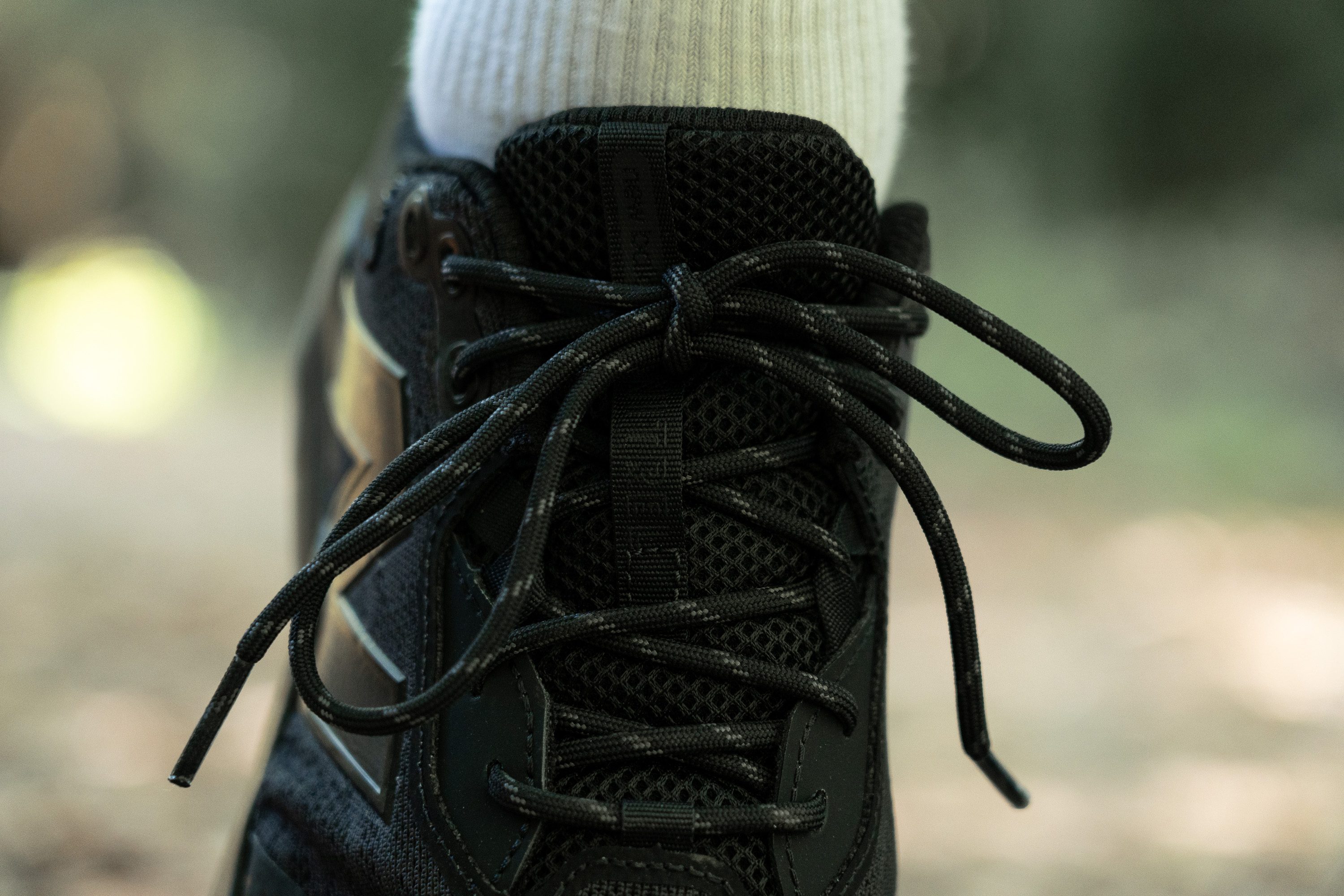
As for the lacing system, it combines lace loops and eyelets with trail-ready rounded laces that enhance its rugged appeal. We also noted the inclusion of a tongue loop, which is absolutely essential since the tongue isn't attached to the sides.
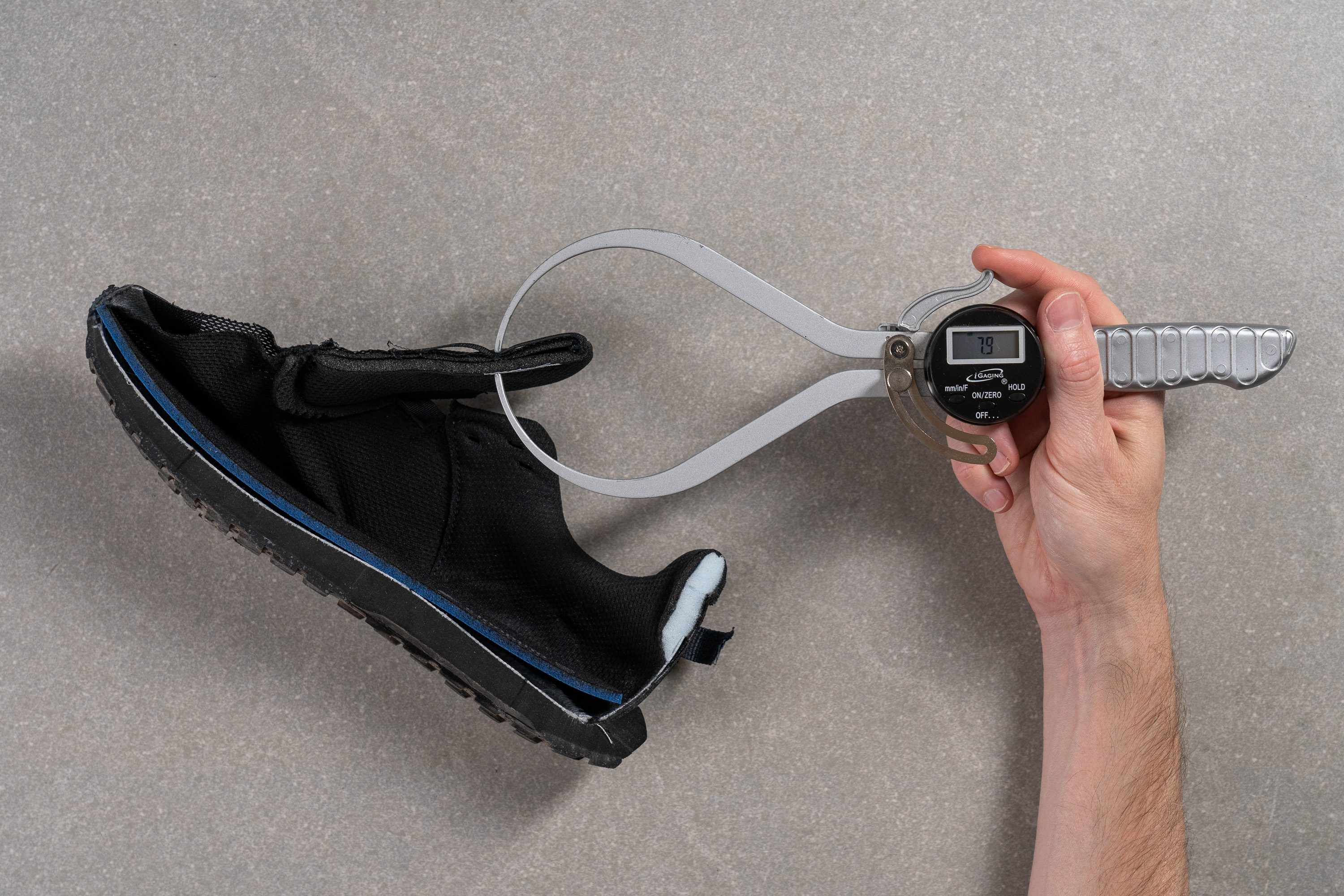
| DynaSoft Nitrel v6 | 7.9 mm |
| Average | 6.4 mm |
Tongue: gusset type
The Nitrel v6 is attractively priced but still lacks a gusseted tongue—a significant shortcoming for a trail and hiking shoe, as this feature helps prevent debris from entering into the toebox.

| DynaSoft Nitrel v6 | None |
Price
We believe the price of this New Balance trail shoe is fair, considering it lacks high-end features yet is still cost-effective compared to most market options. In fact, it ranks as one of the top value choices available, especially since it retails well below the average price.
| DynaSoft Nitrel v6 | $75 |
Heel tab
One of the nice updates in the Nitrel v6 is the addition of a horizontal finger-loop heel tab. This feature is a pleasant surprise, as it's rare in cheap models and was absent in the previous edition of the Nitrel.
While we found that the heel tab may not be the most rock-solid ever created, its presence definitely enhances the trail-ready appearance of the Nitrel v6!

| DynaSoft Nitrel v6 | Finger loop |

